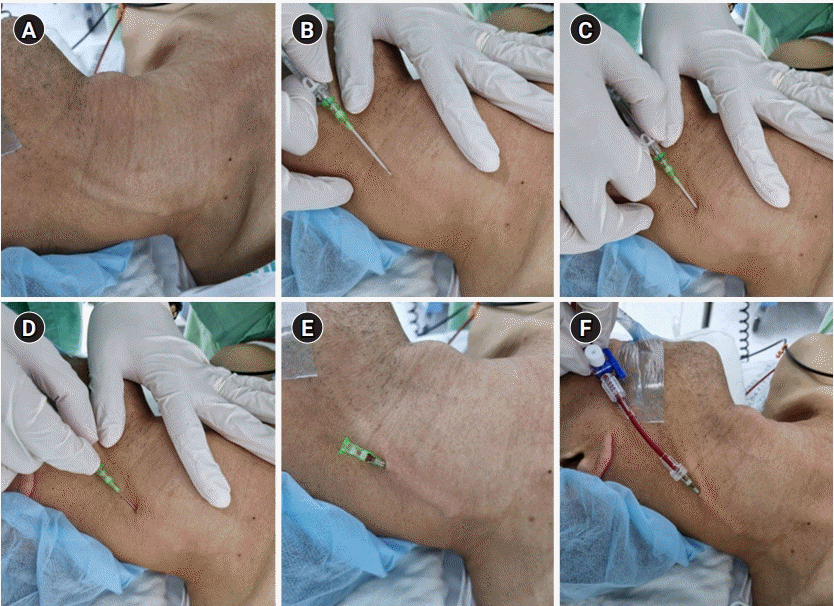1. Costantino TG, Kirtz JF, Satz WA. Ultrasound-guided peripheral venous access vs. the external jugular vein as the initial approach to the patient with difficult vascular access. J Emerg Med. 2010; 39:462–7.

2. Piredda M, Biagioli V, Barrella B, Carpisassi I, Ghinelli R, Giannarelli D, et al. Factors affecting difficult peripheral intravenous cannulation in adults: a prospective observational study. J Clin Nurs. 2017; 26:1074–84.

3. Ju JW, Oh Y, Yang HJ, Lee S, Bae J, Nam K, et al. Hemodialysis as a risk factor for lower right internal jugular stenosis in cardiac surgery patients: a retrospective single-center study. J Clin Med. 2021; 10:1042.

4. Parienti JJ, Mongardon N, Mégarbane B, Mira JP, Kalfon P, Gros A, et al. 3SITES Study Group. Intravascular complications of central venous catheterization by insertion site. N Engl J Med. 2015; 373:1220–9.

5. Ahmad SR, Bellapukonda S, Mohanty CR, Tapuria P. External jugular vein cannulation - a double-edged sword. Indian J Anaesth. 2021; 65:173–4.

6. Chakravarthy M, Krishnamoorthy J, Nallam S, Kolur N, Faris A, Reddy K, et al. External jugular venous route for central venous access: our experience in 563 surgical patients. J Anesth Clin Res. 2011; 2:1000144.

7. Segura-Vasi AM, Suelto MD, Boudreaux AM. External jugular vein cannulation for central venous access. Anesth Analg. 1999; 88:692–3.

8. Byth PL. Evaluation of the technique of central venous catheterisation via the external jugular vein using the J-wire. Anaesth Intensive Care. 1985; 13:131–3.

9. Hedges JR, Barsan WB, Doan LA, Joyce SM, Lukes SJ, Dalsey WC, et al. Central versus peripheral intravenous routes in cardiopulmonary resuscitation. Am J Emerg Med. 1984; 2:385–90.

10. Stein J, George B, River G, Hebig A, McDermott D. Ultrasonographically guided peripheral intravenous cannulation in emergency department patients with difficult intravenous access: a randomized trial. Ann Emerg Med. 2009; 54:33–40.

11. Poli de Figueiredo L, Neto A, Janiewski M, Silva JAM, Knobel E. The external jugular vein as the first choice for central venous access in critically ill patients with severe coagulopathy. Crit Care. 2001; 5(Suppl 3):P95.
12. von Elm E, Altman DG, Egger M, Pocock SJ, Gøtzsche PC, Vandenbroucke JP; STROBE Initiative. The Strengthening the reporting of observational studies in epidemiology (STROBE) statement: guidelines for reporting observational studies. Ann Intern Med 2007; 147: 573-7. Erratum in: Ann Intern Med. 2008; 148:168.
13. Dalip D, Iwanaga J, Loukas M, Oskouian RJ, Tubbs RS. Review of the variations of the superficial veins of the neck. Cureus. 2018; 10:e2826.

14. Khandhar SJ, Schatz CL, Collins DT, Graling PR, Rosner CM, Mahajan AK, et al. Thoracic enhanced recovery with ambulation after surgery: a 6-year experience. Eur J Cardiothorac Surg. 2018; 53:1192–8.

15. Miyazaki T, Yamasaki N, Tsuchiya T, Matsumoto K, Hatachi G, Kitamura Y, et al. Management of unexpected intraoperative bleeding during thoracoscopic pulmonary resection: a single institutional experience. Surg Today. 2016; 46:901–7.

16. Lahtinen P, Musialowicz T, Hyppölä H, Kiviniemi V, Kurola J. Is external jugular vein cannulation feasible in emergency care? A randomised study in open heart surgery patients. Resuscitation. 2009; 80:1361–4.

17. Mitre CI, Golea A, Acalovschi I, Mocan T, Caea AM, Ruţă C, et al. Ultrasound-guided external jugular vein cannulation for central venous access by inexperienced trainees. Eur J Anaesthesiol. 2010; 27:300–3.

18. McGee DC, Gould MK. Preventing complications of central venous catheterization. N Engl J Med. 2003; 348:1123–33.

19. Jobes DR, Schwartz AJ, Greenhow DE, Stephenson LW, Ellison N. Safer jugular vein cannulation: recognition of arterial puncture and preferential use of the external jugular route. Anesthesiology. 1983; 59:353–5.
20. Mohanty CR, Ahmad SR, Jain M, Sriramka B. Air embolism through open hub of external jugular vein intravenous cannula. Turk J Emerg Med. 2019; 19:117–9.

21. Mohanty CR, Panda R. Fracture and embolization of intravenous cannula placed in external jugular vein: a rare complication. Saudi J Anaesth. 2018; 12:504–5.

22. Saeki N, Kawamoto M. Tracheal obstruction caused by fluid extravasation during shoulder arthroscopy. Anaesth Intensive Care. 2011; 39:317–8.
23. Clevens RA, Bradford CR. Airway obstruction secondary to central line intravenous fluid extravasation. Arch Otolaryngol Head Neck Surg. 1994; 120:437–9.

24. Schummer W, Schummer C, Bayer O, Müller A, Bredle D, Karzai W. Extravasation injury in the perioperative setting. Anesth Analg. 2005; 100:722–7.

25. Deslaugiers B, Vaysse P, Combes JM, Guitard J, Moscovici J, Visentin M, et al. Contribution to the study of the tributaries and the termination of the external jugular vein. Surg Radiol Anat. 1994; 16:173–7.

26. Ahn S, Lee JH, Park C, Hong YW, Chun DH. Malposition of central venous catheter in the jugular venous arch via external jugular vein - a case report. Korean J Anesthesiol. 2015; 68:175–8.

27. Tecklenburg FW, Cochran JB, Webb SA, Habib DM, Losek JD. Central venous access via external jugular vein in children. Pediatr Emerg Care. 2010; 26:554–7.

28. Akman M. Simplify long-term venous access via external jugular vein in children. Ann Pediatr Surg. 2021; 17:29.






 PDF
PDF Citation
Citation Print
Print



 XML Download
XML Download